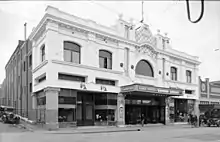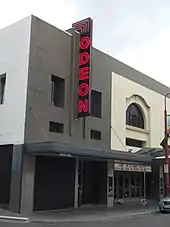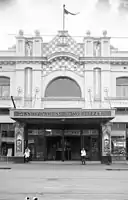The Strand Theatre, ABC Odeon Theatre | |
 Odeon Theatre at night, 1970s | |
| Address | 167 Liverpool Street Hobart, Tasmania Australia |
|---|---|
| Coordinates | 42°52′59.4″S 147°19′29.27″E / 42.883167°S 147.3247972°E |
| Owner | Riverlee |
| Capacity | 1,690[1] |
| Current use | live entertainment |
| Construction | |
| Opened | 21 May 1916 |
| Rebuilt | 1956 |
| Years active | 1916-1970, 2011-present |
| Architect | George Stanley Crisp (1916)[2] Guy Crick & Associates (1956) |
| Website | |
| Official site | |
The Odeon Theatre (formerly known as The Strand Theatre) is a historic former cinema and live entertainment venue in the city of Hobart, Tasmania, Australia.
History
Tasmanian entrepreneur E.J. Miller envisioned a world-class picture theatre in Hobart after witnessing firsthand the rising popularity of silent films in vaudeville programming at Zeehan's Gaiety Theatre and Theatre Royal.[3] Miller, whose wealth was derived from the lucrative Zeehan mineral field, travelled to the United States, visited major cities and studied the latest advancements in picture theatre designs. On his return to Tasmania he engaged with Hobart architect George Stanley Crisp, who had previously designed the art nouveau Palace Theatre opposite the Hobart GPO on Elizabeth Street. Located on the corner of Liverpool Street and Watchorn Street, Miller's original theatre design was intended to be a replica of The Strand in New York.[4]

The Strand Theatre
An exceptional example of the Federation Free Classical style, the building featured an iconic checkered parapet, composite order pilasters, decorative cornices, leadlight windows and wrought iron lanterns. Internally, it featured seating for 1,200 people (719 in the stalls and 481 in the dress circle),[3] a Tasmanian Blackwood staircase and dress circle, Wunderlich ceilings, three cloak rooms, immersive wall murals, as well as fixtures and fittings manufactured in Glenorchy.[4] Built as a silent picture house, when The Strand Theatre opened on May 22, 1916, mayor L.H. Macleod declared "this is undoubtedly the finest building in Tasmania".[4] The venue was equipped with state-of-the-art technology, including dimmable atmospheric lighting, early electric ticketing machines, projection equipment imported from Britain and a six-rank Wurlitzer organ, the only of its kind in Tasmania.[5] Located at the west end of Hobart's CBD along the busy Liverpool Street tram line and directly opposite His Majesty's Theatre, locals referred to the "west end" when visiting the pictures or theatre.[note 1]
From 1918 to 1920, nimbyism lead to some residents demanding the government set up a Board of Censors to protect Tasmanian audiences from the "moral decay" associated with the show business world, escalating after a screening of Enlighten Thy Daughter at The Strand in 1920. The board was dissolved when the exhibitor complained of reduced patronage.[1][4]
The cinema was taken over by Union Theatres, remodelled and relaunched with the Marx Brothers film The Cocoanuts in 1929.[1] Sound equipment was installed and the venue was colloquially referred to as the "New Strand Theatre".[6]

Modernisation as the Odeon
In the mid-1950s, then-exhibitor Greater Union engaged with Sydney-based architects Guy Crick & Associates to modernise the theatre. The Strand underwent serious alterations, leaving the building both internally and externally unrecognisable. The façade was covered in rainscreen cladding to present in a modernist style. To achieve this effect, its cornices and pilasters were chiseled back, its parapet was partially levelled, leadlight windows discarded and wrought iron features removed. Modernist neon signage was erected. It reopened as the Odeon Theatre in 1956, the year of the Melbourne Olympics which saw the introduction of television across Australia. Although branded as "The Theatre of Tomorrow", Greater Union did not foresee the lasting effect of television.[7]
ABC Odeon Theatre
The Odeon fell into financial hardship and was purchased by the ABC in 1970, becoming a recording studio for ABC Radio. During the ABC's tenureship, it was known as the ABC Odeon Theatre, and internally referred to as Studio 720. At some point, pieces of cladding were removed to reveal several windows, including the central arch, to allow more light into the upstairs foyer.[8] It became the home of the Tasmanian Symphony Orchestra (TSO) in 1973. The TSO broadcast many radio and television performances from the theatre and recorded several albums. In 1978, vocalist Judith Durham of The Seekers and pianist Ron Edgeworth recorded material for their live album, The Hot Jazz Duo at the theatre. Other musicians to record at the Odeon include Larry Sitsky, Jan Sedivka, Ade Monsbourgh, Judi Connelli, Suzanne Johnston, Guy Noble, Deborah Conway, George Dreyfus, Scared Weird Little Guys, David Porcelijn,[9] James Ledger,[10] tenor Donald Smith, composer Michael Smetanin[11] and the Australian Rosny Children's Choir.[12][13] An ABC Shop occupied the Watchorn Street corner shopfront in the 1990s.

Over time, the world-class orchestra outgrew the theatre's amenities, with the dressing rooms and backstage facilities noted as being especially inadequate. After 28 years, the TSO relocated to Federation Concert Hall in 2001. The Odeon was then purchased by the Christian City Church, who renovated the interior and restored many of the original Federation-era features.[4]
Riverlee and DarkLab redevelopment
In 2009, the Christian City Church sold the Odeon to Melbourne-based developer Riverlee. The building remained dormant for several years until it reopened as a live entertainment venue, charged by events curated for the MONA FOMA and Dark Mofo festivals. Hobart City Council gave permission for the building to be partially demolished in 2015. Initially, Riverlee planned to develop the building into a $69 million 11-story office tower accommodating some 1,850 workers, and included shops, restaurants and car parking.[14][15] The original building façade, disfigured beneath its 1950s cladding, was required to be retained and restored.[16][17]
Riverlee acquired more properties on the block bound by Liverpool Street, Murray Street, and Watchorn Street that contain the Odeon Theatre and Tattersalls Hotel. The site has an 80 metres (260 ft) frontage along Liverpool Street. A town planning permit has been obtained for a commercial building of over 20,000 square metres (220,000 sq ft) net lettable area.[18][19]
In 2019, the Odeon and surrounding "Hanging Garden" cultural precinct underwent a $5 million mixed-use redevelopment. The scheme was developed in partnership with DarkLab, a subsidiary of the Museum of Old and New Art, which works on creative projects outside the usual scope of Mona.[20][21]
2022 masterplan
In September 2022, Riveree and DarkLab unveiled a new masterplan for the Hanging Garden Precinct. Designed by Melbourne-based architects Fender Katsalidis with support from Six Degrees Architects, the new development outlines retaining and restoring the Odeon Theatre auditorium, whilst developing a fifteen story, "180+ key hotel" directly above the upper lobby area.[22]
Film premieres
During its tenure as The Strand, the theatre hosted Tasmanian premieres for many Australian-made films, including Jewelled Nights (1925), which was attended by author Marie Bjelke Petersen, future-Prime Minister Joseph Lyons (then-Premier of Tasmania), Dame Enid Lyons and mayor F. D. Valentine.[23] Other Tasmanian premieres included The Squatter's Daughter, with a special appearance from actress Jocelyn Howarth,[24] A Son is Born[25] and the Australian premiere of Wherever She Goes (1951), a film about the life Zeehan-born pianist Eileen Joyce, which was introduced by Tasmanian Premier Robert Cosgrove.[26][27] Based on the novel by Nan Chauncy, the Tasmanian feature film They Found a Cave premiered at the Odeon Theatre on 20 December 1962.[28][29]
Orchestra pit
Enhancing emotions, suspense, and atmosphere, The Strand Orchestra occupied the orchestra pit near the audience, adding grandeur and sophistication to silent film screenings. The impact of talkies lead to the disbanding of The Strand Orchestra by the mid 1930s and by 1940 the Wurlitzer organ was out of use.[30] The cinema last used the orchestra pit for musical entertainment in 1957 to raise funds for a Miss Tasmania contestant, named "Miss Greater Union Theatres".[5] The orchestra pit would go to the be utilised by the TSO.

Wurlitzer organ
The Strand's six-rank Wurlitzer organ was installed by organ builder, J.E. Dodd on 16 November 1918. Between 1920 and 1928, the organ was operated by Ben Corrick, who also conducted The Strand Orchestra (on occasion from behind the organ's console).[1][4][5] A remodeling of the theatre in 1929 saw Fincham and Sons restore the organ, with the console's height apparently reduced due to the discontinuity of roll players in the new era of "talkies". In contrast to the original console, the altered version featured curved cabinetry that emulated the style of popular "horseshoe style" theatre organs, but retained the straight stop rails. Renowned theatre organist Manny Aarons came to reopen the instrument in 1929. Falling into disuse in the late 1930s, the organ was eventually removed in 1948 and reinstalled in the Hurstville Presbyterian Church, New South Wales, Australia.[31]
Contemporary use
Following a sold-out show of Queens of the Stone Age at the Odeon in 2014,[32] the venue has been utilised by MONA FOMA and Dark Mofo festivals hosting events including Laurie Anderson, Nick Cave, Sarah Blasko, Archie Roach, Paul Kelly, King Gizzard & the Lizard Wizard, Cate Le Bon, Sharon Van Etten, Nick Murphy, Tim Minchin, Everclear, The Tea Party, The Dillinger Escape Plan, Einstürzende Neubauten and Xavier Rudd.[33][34] It has also been used as a venue for the Festival of Voices.[35]
Gallery
All images have been sourced from the Tasmanian Archive and Heritage Office.
 Image showcasing the theatre's iconic checkered parapet and led light windows. Marquee advertising guest Wurlitzer organist, Manny Aarons
Image showcasing the theatre's iconic checkered parapet and led light windows. Marquee advertising guest Wurlitzer organist, Manny Aarons Interior upstairs foyer featuring a Wunderlich ceiling, blackwood staircase, carpets, lamps, lighting fixtures, paintings, urns and plants
Interior upstairs foyer featuring a Wunderlich ceiling, blackwood staircase, carpets, lamps, lighting fixtures, paintings, urns and plants Interior of the auditorium facing the stalls, showcasing its blackwood mezzanine, Wunderlich ceiling and wall murals
Interior of the auditorium facing the stalls, showcasing its blackwood mezzanine, Wunderlich ceiling and wall murals
See also
Notes
- ↑ Village Cinemas capitalised on the "West End" namesake in 1976, naming Tasmania's first multiplex on nearby Collins Street the West End Twin. It was expanded to 7 screens and renamed Village Cinemas in 1988.
References
- 1 2 3 4 "Odeon Theatre,167 Liverpool Street, Hobart, TAS 7000". Cinema Treasures. Retrieved 10 May 2022.
- ↑ Tasmanian Heritage Register Datasheet (PDF), Tasmanian Heritage Council, p. 4, retrieved 12 May 2022
- 1 2 Martell 2018, p. 36.
- 1 2 3 4 5 6 McIntyre, Paul (9 November 2015). "The history of Hobart's Odeon Theatre, the 'finest building in Tasmania'". Australian Broadcasting Corporation. Retrieved 10 May 2022.
- 1 2 3 Corby 2017, p. 25.
- ↑ "At the Theatres: The Strand". Huon Times. Franklin, Tasmania. 1 April 1932. p. 2. Retrieved 15 May 2022 – via Trove.
- ↑ Jacobson, Adrian. "The Companion to Tasmanian History - Picture Theatres". University of Tasmania. Retrieved 10 May 2022.
- ↑ Martell 2018, p. 37.
- ↑ "Australian Composers Orchestral Forum 1999". Australian Music Centre. Retrieved 15 May 2022.
- ↑ "Air Man: Full Orchestra by James Ledger (1999)". Australian Music Centre. Retrieved 15 May 2022.
- ↑ "Michael Smetanin: Kuzanagi (1999)". Australian Broadcasting Corporation. 19 November 2018. Retrieved 13 May 2022.
- ↑ "ABC Odeon, Hobart". Discogs. Retrieved 13 May 2022.
- ↑ Annual Report 1998-99 (PDF), Australian Broadcasting Corporation, p. 63, retrieved 16 May 2022
- ↑ Howard, Jessica (3 July 2014). "Proposed office development of Hobart's Odeon Theatre on hold until local market improves". The Mercury. Retrieved 20 July 2022.
- ↑ Howard, Jessica (21 April 2015). "Historic Odeon Theatre hits big stage with $69 million multi-purpose makeover". The Mercury. Retrieved 11 May 2022.
- ↑ "Hobart City Council renews demolition green light for Odeon". abc.net.au. 27 October 2015. Retrieved 10 May 2022.
- ↑ Crawley, Jennifer (1 June 2017). "Permit extension call to save the Odeon for Mona's DarkLab arts mecca plan". The Mercury. Retrieved 14 May 2022.
- ↑ ""The Hanging Garden" Precinct". riverlee.com.au. Retrieved 10 May 2022.
- ↑ Howard, Jessica (3 May 2019). "DarkLab and developer Riverlee set to open $5m 'In the Hanging Garden' cultural precinct in Hobart's CBD". The Mercury. Retrieved 10 May 2022.
- ↑ Boyd, Tim (28 May 2019). "Development in Hobart saves historic theatre". Australian Financial Review. Retrieved 10 May 2022.
- ↑ Needham, Jack (22 November 2019). "Riverlee and Darklab permanently reopen In The Hanging Garden in Hobart". commercialrealestate.com.au. Retrieved 10 May 2022.
- ↑ "Works progressing on Hobart's 'In The Hanging Garden' precinct by DarkLab & Riverlee". The Hotel Conversation. 13 September 2022. Retrieved 15 November 2022.
- ↑ "Jewelled Nights Premiere at The Strand". The Mercury. Hobart. 5 January 1926. p. 4. Retrieved 14 May 2022 – via Trove.
- ↑ "Entertainments: Strand Theatre". The Mercury. Hobart. 17 October 1933. p. 5. Retrieved 14 May 2022 – via Trove.
- ↑ "Premiere: A Son Is Born". The Mercury. Hobart. 19 October 1946. p. 6. Retrieved 14 May 2022 – via Trove.
- ↑ "Odeon Theatre,167 Liverpool Street, Hobart, TAS 7000 (Photos)". Cinema Treasures. Retrieved 14 May 2022.
- ↑ "Film on Pianist Meets Praise". The Mercury. Hobart. 8 September 1951. p. 3. Retrieved 14 May 2022 – via Trove.
- ↑ Pike, Andrew; Cooper, Ross (1980). Australian Film 1900-1977 (1998 ed.). Melbourne, Australia: Oxford University Press. p. 232. ISBN 0-19-550784-3.
- ↑ "They Found a Cave". Oz Movies. Retrieved 25 July 2022.
- ↑ Corby 2017, p. 26.
- ↑ Blackmore, Rodney (1 June 2013). "A Little-known Sydney Wurlitzer". The Sydney Organ Journal. 44 (3): 25–26.
- ↑ Gelston, Scott (25 March 2014). "Gallery: Queens of the Stone Age play Hobart". The Examiner (Tasmania). Retrieved 20 July 2022.
- ↑ "The Odeon Theatre". onlytasmania.com.au. Retrieved 10 May 2022.
- ↑ "Odeon Theatre Hobart Concert Setlists". setlist.fm. setlist.fm - The Set List Wiki. At bottom of page, click arrow to go to next page. Concerts may also be searched by artist in top menu. Retrieved 20 July 2022.
- ↑ James, Erin (6 July 2012). "Artistic Director Kris Stewart's top picks for Hobart's Festival of Voices". Aussie Theatre. Retrieved 14 May 2022.
Sources
- Corby, Phil (2017). "The Picture Theatre Orchestra: A Tasmanian Perspective". Cinema Record Quarterly Journal. No. 94 (2 ed.). ISSN 1443-3664. Retrieved 14 May 2022.
- Martell, Earl (December 2018). "Strand/Odeon Theatre". Cinema Record Quarterly Journal. No. 100 (4 ed.). ISSN 1443-3664. Retrieved 14 May 2022.